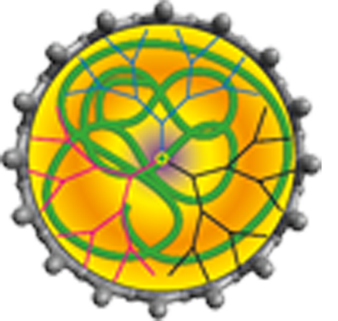Supramolecular Functionalization of Carbon Nanotubes
Supramolecular functionalization of nanotubes is advantageous in that it avoids the formation of covalent bonds to the nanotube surface and therefore avoids the introduction of defects. This preserves the superior conductivity and strength properties of nanotubes. Planar aromatic molecules, such as pyrene and porphyrins, are known to pi-stack to the nanotube surface. We have recently begun to explore the interactions of conjugated polymers with carbon nanotubes. This has included the investigation of polyfluorene and polythiophene derivatives, polycarbazoles, and a number of other unique conjugated polymers and block copolymers. The eventual aim of this work is to identify polymers that selectively interact with specific types of carbon nanotubes (specific chiralities, diameters, and selectivity between metallic and semiconducting structures).
Polyfluorene and poly(fluorene-co-thiophene) derivatives strongly interact with SWNTs and impart solubility in organic solvents, enabling the formation of stable complexes with interesting photophysical properties.

More recently, we prepared a novel 2,7-carbazole monomer unit and used it to prepare two poly(2,7-carbazole)s, both of which were obtained in relatively high molecular weights and display excellent solubility in common organic solvents. The polymers were able to effectively disperse carbon nanotube bundles in either THF or toluene using a relatively simple procedure to yield fairly concentrated polymer-carbon nanotube samples that were stable for months. We have shown that these polymers interact selectively with semiconducting SWNTs, and are currently working to exploit this effect further.

In some of our latest work, we are also developing methods for binding and subsequent release of SWNTs with specifically designed conjugated polymers that respond to external stimuli. Using the polymer structure below, we were able to cause the resulting polymer-nanotube complex to undergo a fast conformational switch upon addition of a drop of TFA, leading to the quantitative precipitation of pure nanotubes. Combination of selective interactions (as above) and binding/release properties will lead to new and valuable tools in nanotube separation, purification, and applications


